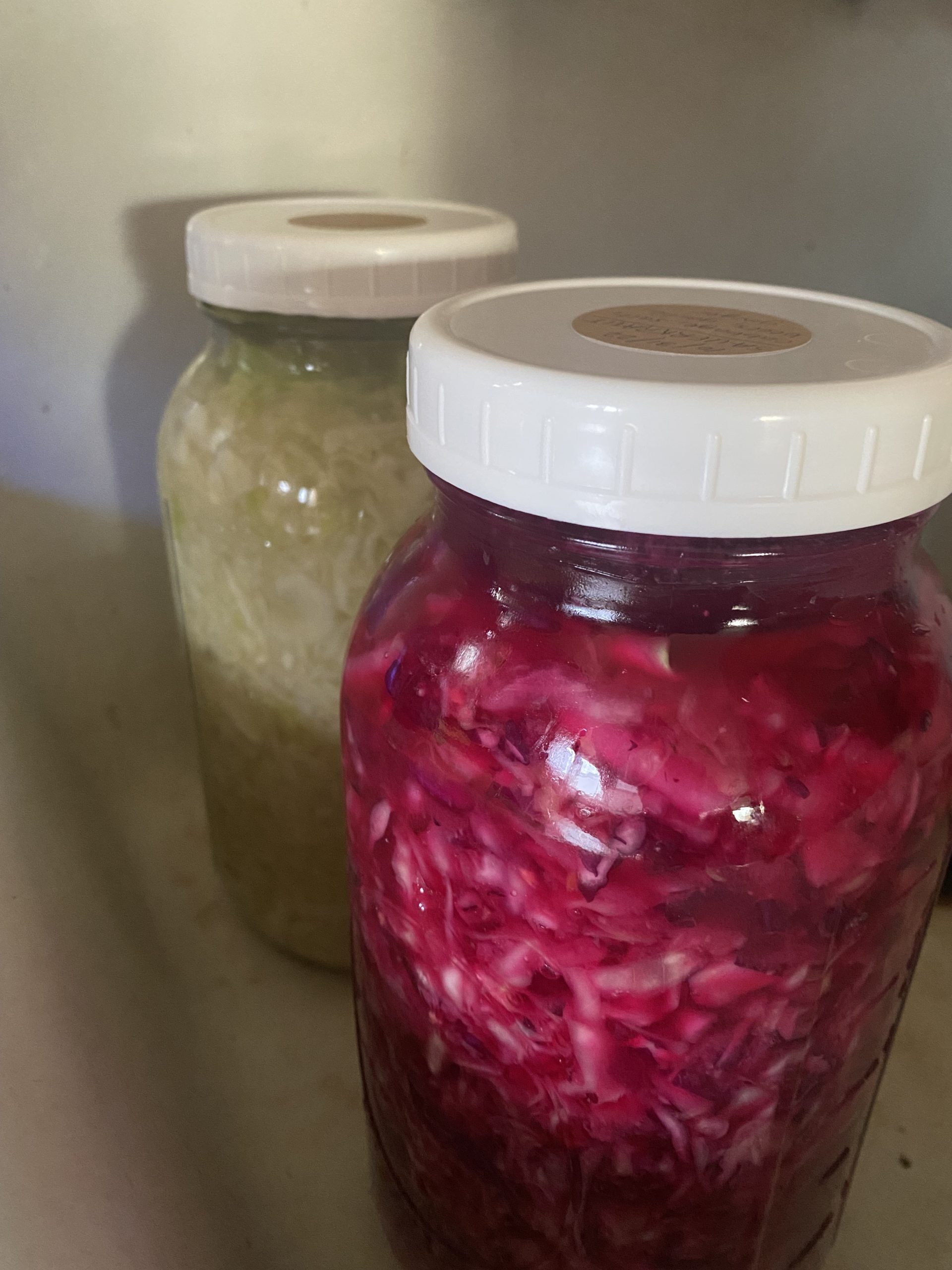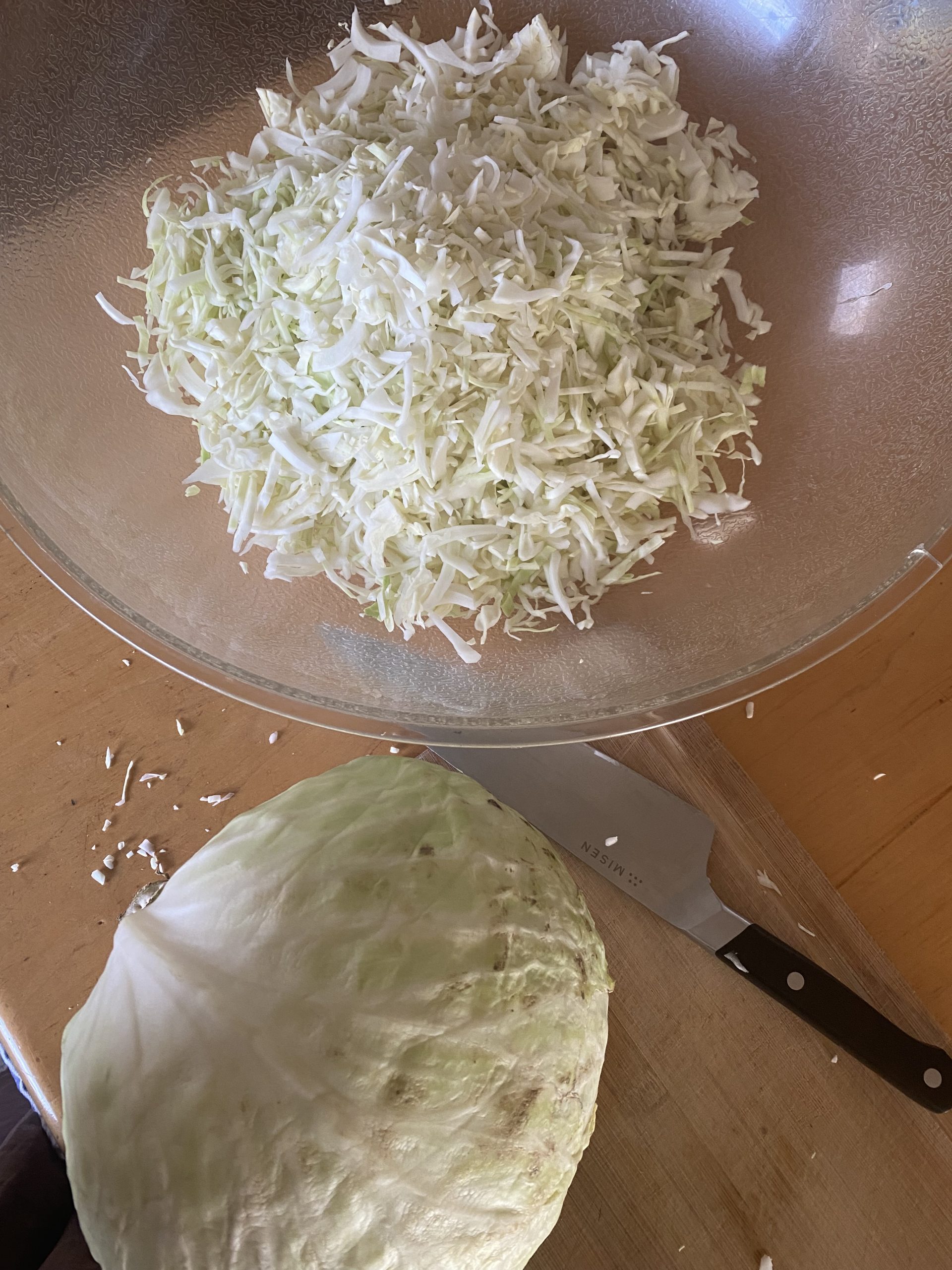People have been using lacto-fermentation as a means of preserving food for thousands of years. Fermented foods like yoghurt, sauerkraut and the like have increasingly documented health benefits. But not all sauerkraut is created equally — most storebought sauerkraut is pasteurized, destroying the live cultures. Homemade sauerkraut, on the other hand, is a living food that retains its active cultures and associated health benefits. It’s crunchy, zingy and vibrant, not at all like the soggy stuff from the storebought jar.
First things first, let’s talk homemade fermentation and food safety.
The process of making sauerkraut is incredibly simple. For food safety reasons, though, weighing and measuring your ingredients carefully is key! As a general rule of thumb, you want your sauerkraut brine to contain around 2.5-3% salt. The salt level keeps troublesome bacteria and mold at bay in order to preserve it, both during and after the fermentation process. A simple way to remember this ratio is to think 1.5-2tsp of salt for every pound of veg.
Keeping the sauerkraut fully submerged in brine, both during and after fermentation, is also important. Sauerkraut fermentation is an anaerobic process, and the more that the cabbage is exposed to air, the higher the chance of spoilage. The simplest way to keep your kraut submerged in the brine is to use a weight inside the jar. I recommend glass fermentation weights, but even a stone (carefully cleaned and sanitized, of course!) will do in a pinch.
During the process of making and fermenting your sauerkraut, be sure to practice good sanitation to prevent introducing any unwanted bacteria into the finished product. Clean all equipment (and your hands!) with hot soapy water before you prepare it, and always serve it with a clean utensil. Sauerkraut will have a sour smell to it after fermenting, but it should never smell putrid, moldy or rotten. If you notice any discoloration, mold growth or off-putting smells, don’t eat it. “When in doubt, throw it out!”
Basic Sauerkraut Recipe
- First, prep your jar, lid and weight(s). For my own kitchen and personal use, a good scrub with hot water and soap, followed by a thorough air-dry, is sufficient sterilization for me. A trick that I like is to stick them in the oven (turned off) to dry. The subtle heat from the pilot light is enough to get them dry and keep them clean til you’re ready to use them.
- Peel off any dry or discolored bits from the outside of the cabbage, and toss in the compost. Set aside one or two leaves in good condition for later.
- Core the cabbage and finely shred it. A mandoline works well for this, but I just use my trusty chef’s knife. Then, place the shredded cabbage in a large bowl.

There will be a lot of chopping. You have been warned. - Add 1.5-2 teaspoons of coarse canning salt for every pound of cabbage. (I recommend weighing it after it’s been cored and sliced for the most accurate measurement!) If adding any other flavorings, do so now. Toss then let it sit for 15 minutes.
- Massage the salt into the cabbage vigorously for another 5 minutes. The cabbage will further release its liquid to form the brine.
- Transfer it all into your clean, dry jar, packing it down as you go. Pour in any brine left in the bowl on top. Fold up the big cabbage leaf you saved earlier and put it on top of the sauerkraut. Then push everything down so it’s submerged in liquid, and add your weight. (If you don’t have enough brine to comfortably submerge everything, top it off with 2% saltwater – 1tsp salt per cup of liquid.)
- Lightly screw on the lid, but don’t tighten it all the way. (The fermentation will produce some air bubbles, so you want to make sure those can escape.) Some liquid may seep out during fermentation, so set it on a plate to reduce mess.
- Leave your sauerkraut to ferment for as little as a few days, up to several weeks. Taste it every day or two until you’re happy with the taste, then tighten the cap and store it in the fridge. Larger batches will likely take longer to ferment. If it seems like you need more liquid to adequately cover it, top it off with more 2% saltwater (1tsp salt for ever 8oz water).

Adding Flavorings to Sauerkraut
Here are just a few suggestions of things you might add to your basic sauerkraut recipe:
- Garlic, finely minced or blended into a paste
- Ginger, finely minced or blended into a paste
- Carrots, finely grated
- Beets, finely grated
- Sweet onion, finely grated or blended into a paste
- Green onions or chives, julienned
- Juniper berries are a very traditional German ingredient. They have a very strong flavor, so you only need a few!
- Traditional pickling spices such as caraway seed, dill seed, or coriander seed
- Savory herbs such as rosemary, thyme or bay could work nicely
(If adding additional vegetables, don’t forget to increase your salt level accordingly! So if you add a half a pound of grated carrots, for example, make sure to add an additional 1 tsp. of salt.)
There you have it! A simple process to create a wonderfully old-fashioned sauerkraut that’s tasty and good for you too. It pairs wonderfully with mashed potatoes, on top of locally made sausages, or stirred into soups just before serving.
